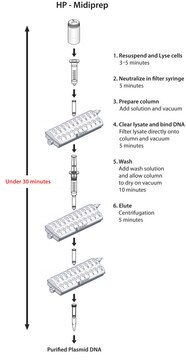Key Documents
G1N10
GenElute™ Mammalian Genomic DNA Miniprep Kits
sufficient for 10 purifications
Synonim(y):
Mammalian Genomic DNA Miniprep, Gen Elute
About This Item
Polecane produkty
Szukasz podobnych produktów? Odwiedź Przewodnik dotyczący porównywania produktów
Opis ogólny
Isolate pure genomic DNA from cultured cells, tissues (including rodent tails), and fresh whole blood or white blood cells. The kit combines the advantages of silica binding with a microspin format and eliminates the need for expensive resins, alcohol precipitation, and hazardous organic compounds such as phenol and chloroform.
Zastosowanie
- restriction endonuclease digestions
- PCR
- Southern blots
- sequencing reactions
- cloning
- ligation
Cechy i korzyści
- Expected yield: 25 μg from 2 x 106 cultured cells; 30 μg from 25 mg of tissue
- Elution volume: 200 - 400 μl
- Time required: 20 min after lysis
- A260/A280 ratio: 1.6 - 1.9
- Mechanical homogenization required: No
Zasada
Inne uwagi
Informacje prawne
Elementy zestawu są też dostępne oddzielnie
polecane
produkt powiązany
Hasło ostrzegawcze
Danger
Zwroty wskazujące rodzaj zagrożenia
Zwroty wskazujące środki ostrożności
Klasyfikacja zagrożeń
Acute Tox. 4 Oral - Aquatic Acute 1 - Aquatic Chronic 2 - Eye Dam. 1 - Met. Corr. 1 - Resp. Sens. 1 - Skin Irrit. 2 - STOT SE 3
Organy docelowe
Respiratory system
Kod klasy składowania
8A - Combustible corrosive hazardous materials
Temperatura zapłonu (°F)
483.8 °F
Temperatura zapłonu (°C)
251 °C
Certyfikaty analizy (CoA)
Poszukaj Certyfikaty analizy (CoA), wpisując numer partii/serii produktów. Numery serii i partii można znaleźć na etykiecie produktu po słowach „seria” lub „partia”.
Masz już ten produkt?
Dokumenty związane z niedawno zakupionymi produktami zostały zamieszczone w Bibliotece dokumentów.
Klienci oglądali również te produkty
Produkty
Proste metody oczyszczania DNA/RNA wspomagają analizę genomu z różnych źródeł, zwiększając efektywność badań.
The availability of simple methods for purification of DNA and RNA has greatly facilitated the analysis and characterization of the genome and gene expression. There is a demand to isolate DNA and RNA rapidly and conveniently from a variety of cellular sources, including cells and tissues from mammalian, plant and bacterial cultures.
Protokoły
Archived Formalin-fixed, Paraffin-embedded (FFPE) tissue samples are invaluable resources for profiling gene expression and studying a variety of diseases.
Zarchiwizowane próbki tkanek utrwalone w formalinie i zatopione w parafinie (FFPE) są nieocenionymi zasobami do profilowania ekspresji genów i badania różnych chorób.
Niniejszy protokół zapewnia prostą i wygodną metodę izolacji, amplifikacji i oczyszczania genomowego DNA z wymazów z policzka. Wymazy z policzka są wygodną metodą pozyskiwania próbek DNA.
This protocol provides a simple and convenient method to isolate, amplify, and purify genomic DNA from buccal swabs. Buccal swabs are a convenient method of acquiring a DNA sample.
Powiązane treści
GenomePlex® Whole Genome Amplification is the method of extracting DNA from the animal sample. GenomePlex® products have been used to amplify genomic DNA from chicken, porcine, bovine, fish, and shrimp source.
Nasz zespół naukowców ma doświadczenie we wszystkich obszarach badań, w tym w naukach przyrodniczych, materiałoznawstwie, syntezie chemicznej, chromatografii, analityce i wielu innych dziedzinach.
Skontaktuj się z zespołem ds. pomocy technicznej












